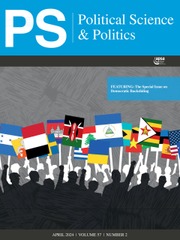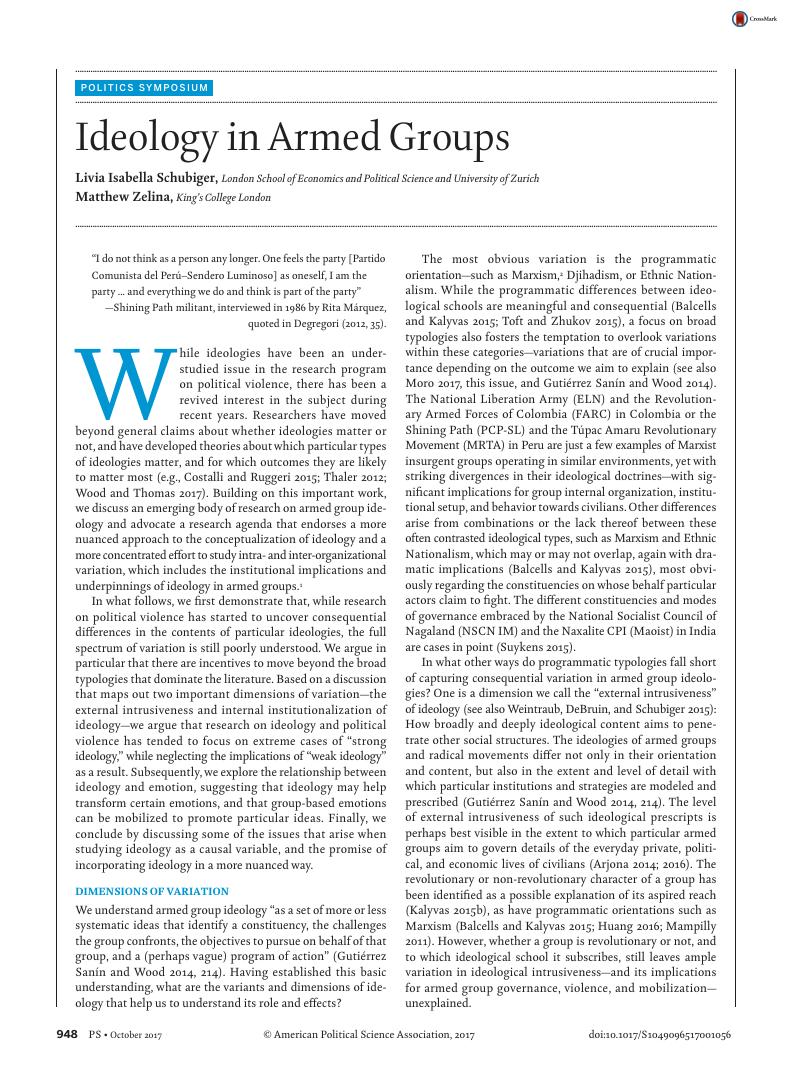Crossref Citations
This article has been cited by the following publications. This list is generated based on data provided by Crossref.
Leader Maynard, Jonathan
2019.
Ideology and armed conflict.
Journal of Peace Research,
Vol. 56,
Issue. 5,
p.
635.
Schulhofer-Wohl, Jonah
2020.
On-Side fighting in civil war: The logic of mortal alignment in Syria.
Rationality and Society,
Vol. 32,
Issue. 4,
p.
402.
Hirschel-Burns, Danny
2021.
Sowing the Seeds: Why do some armed groups socialise civilians more than others during civil war?.
Civil Wars,
Vol. 23,
Issue. 4,
p.
545.
Tominaga, Yasutaka
2021.
Organizational context matters: explaining different responses to militant leadership targeting.
Conflict Management and Peace Science,
Vol. 38,
Issue. 3,
p.
270.
Ruiz Rosendo, Lucía
2021.
Interpreting Conflict.
p.
155.
Conrad, Justin
Greene, Kevin T.
Phillips, Brian J.
and
Daly, Samantha
2021.
Competition from Within: Ethnicity, Power, and Militant Group Rivalry.
Defence and Peace Economics,
Vol. 32,
Issue. 6,
p.
757.
Basedau, Matthias
Deitch, Mora
and
Zellman, Ariel
2022.
Rebels with a Cause: Does Ideology Make Armed Conflicts Longer and Bloodier?.
Journal of Conflict Resolution,
Vol. 66,
Issue. 10,
p.
1826.
Giezendanner, Eliane
and
Ingelaere, Bert
2022.
What structures ex-combatants’ political participation? Exploring the dynamics of identification and groupness in rebel-to-party transformations.
Conflict, Security & Development,
Vol. 22,
Issue. 2,
p.
165.
Bell, Andrew M
Gift, Thomas
and
Monten, Jonathan
2022.
The moral foundations of restraint: Partisanship, military training, and norms of civilian protection.
Journal of Peace Research,
Vol. 59,
Issue. 5,
p.
694.
Corradi, Edoardo
2023.
Beyond Armed Competition: The Logic of Rebel Groups’ Alliance Formation.
Civil Wars,
Vol. 25,
Issue. 2-3,
p.
249.
Pfeifer, Hanna
and
Schwab, Regine
2023.
Politicising the rebel governance paradigm. Critical appraisal and expansion of a research agenda.
Small Wars & Insurgencies,
Vol. 34,
Issue. 1,
p.
1.
Abramson, Scott F
and
Qiu, Xiaoyan
2025.
A cause to fight.
American Journal of Political Science,
Arslan, Mehmet Erdem
2025.
Targeting telecommunications: Why do rebel groups target information and communication technology infrastructure?.
Journal of Peace Research,
Vol. 62,
Issue. 4,
p.
945.
BALCELLS, LAIA
and
KALYVAS, STATHIS N.
2025.
Ideology and Revolution in Civil Wars: The “Marxist Paradox”.
American Political Science Review,
p.
1.
Schmid, Christina
and
Phelan, Alexandra
2025.
Insurgencies as gendered organisations: a synthetical approach to understanding gender relations in insurgent groups.
Critical Studies on Terrorism,
Vol. 18,
Issue. 1,
p.
19.



